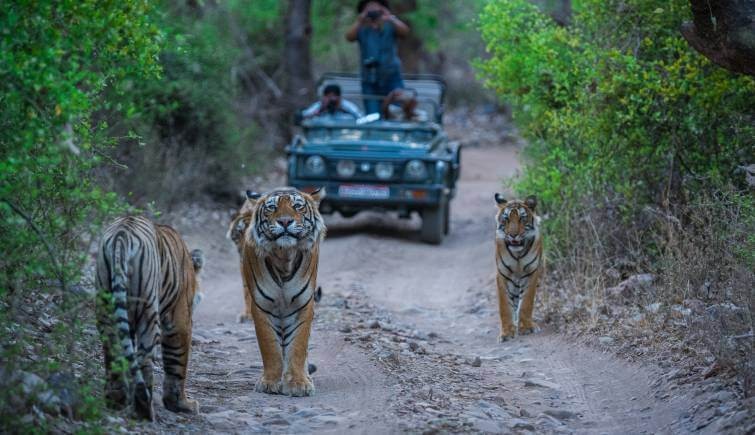Tourism plays a vital role in tiger conservation by providing financial support, raising awareness, and promoting sustainable practices. SIXT.VN understands the importance of responsible travel, offering seamless services to help you explore Vietnam’s natural beauty while contributing to wildlife preservation. Discover how your travel choices can positively impact tiger populations, fostering eco-tourism, conservation efforts, and community support.
1. What is Tiger Tourism and Why Is It Important?
Tiger tourism is defined as traveling to national parks and wildlife sanctuaries to observe tigers in their natural habitats. It’s crucial because it fosters conservation and raises awareness about the tigers’ endangered status. According to the World Wildlife Fund (WWF), tiger tourism, when managed responsibly, is an important tool for species preservation.
Tiger tourism includes activities like:
- Guided Jeep Safaris: Explore the jungle with experienced guides.
- Walking Tours: Discover the smaller details of the tiger’s habitat.
- Elephant-back Rides: (Controversial and often discouraged due to ethical concerns).
- Boat Trips: Observe tigers from a different perspective in riverine habitats.
- Eco-lodges: Stay in accommodations near protected areas for an immersive experience.
2. What is Tiger Conservation and What Does It Entail?
Tiger conservation refers to efforts aimed at protecting wild tiger populations from threats that endanger their survival, ensuring their habitats remain protected. The International Union for Conservation of Nature (IUCN) emphasizes that successful tiger conservation integrates habitat preservation, anti-poaching measures, and community involvement.
Key components of tiger conservation include:
- Habitat Protection and Restoration: Crucial for providing tigers with sufficient space to live and hunt.
- Anti-Poaching Efforts: Involve monitoring tiger populations and preventing illegal wildlife trade.
- Conflict Mitigation: Addresses issues arising from human populations encroaching on tiger habitats.
- Education and Awareness: Promotes support for conservation efforts by informing people about tigers and the threats they face.
- Community Involvement: Engaging local communities in conservation efforts, providing alternative livelihoods.
 Tiger Sightings
Tiger Sightings
3. How Does Tourism Provide Financial Benefits for Tiger Conservation Efforts?
Tourism generates revenue for conservation efforts by funding anti-poaching patrols, habitat restoration, and community-based conservation initiatives, which helps support local economies and reduce reliance on unsustainable practices. According to research from the United Nations Environment Programme (UNEP), in 2022, tourism revenue directly allocated to conservation efforts has proven highly effective in safeguarding tiger populations.
Tourism revenue helps fund:
- Anti-Poaching Patrols: Combating illegal hunting.
- Habitat Restoration: Improving tiger environments.
- Community-Based Conservation: Empowering local communities to protect tigers.
- Infrastructure Development: Building research stations and visitor centers.
- Educational Programs: Raising awareness among tourists and locals.
4. In What Ways Does Tourism Increase Awareness and Education About Tigers?
Tourism provides educational opportunities for people to learn about tigers and their conservation needs by fostering empathy and inspiring action to protect these animals and their habitats. A study by the Tourism Authority of Thailand in 2021 indicates that tourists who participate in responsible wildlife tours are more likely to support conservation initiatives back home.
Tourism increases awareness through:
- Educational Tours: Guided tours that educate visitors about tiger biology and conservation challenges.
- Visitor Centers: Offering exhibits and information on tiger conservation efforts.
- Documentary Screenings: Showcasing the lives of tigers and the threats they face.
- Community Engagement Programs: Involving local communities in educating tourists.
- Online Campaigns: Reaching a broader audience through social media and websites.
 Tiger Tourism
Tiger Tourism
5. How Can Sustainable Ecotourism Incentivize the Conservation of Tiger Habitats?
Sustainable ecotourism encourages sustainable land-use practices, community-based conservation, and wildlife-friendly agriculture, providing alternative livelihoods for local communities to protect tiger habitats. Research from Conservation International, published in 2023, demonstrates that ecotourism projects near tiger habitats lead to significant reductions in deforestation rates.
Sustainable ecotourism provides incentives by:
- Promoting Community-Based Conservation: Encouraging local communities to manage and protect tiger habitats.
- Supporting Wildlife-Friendly Agriculture: Helping farmers adopt practices that minimize harm to tigers and their prey.
- Offering Alternative Livelihoods: Providing jobs in ecotourism, reducing reliance on destructive practices like logging and poaching.
- Generating Revenue for Conservation: Ensuring that tourism revenue is reinvested in tiger conservation efforts.
- Raising Awareness Among Tourists: Educating visitors about the importance of sustainable tourism practices.
6. Can Tourism Improve Local Conservation Policies for Tiger Protection?
Tourism can influence policies and laws by generating political pressure for better protection of tigers and their habitats. A report by the World Tourism Organization (UNWTO) in 2020 highlights that destinations with strong ecotourism sectors tend to have more robust environmental protection policies.
Tourism improves policies by:
- Lobbying for Stronger Laws: Encouraging governments to enact and enforce laws that protect tigers and their habitats.
- Creating Economic Incentives: Demonstrating the economic value of tiger conservation, which can influence policy decisions.
- Raising Public Awareness: Building public support for conservation policies.
- Promoting International Cooperation: Encouraging collaboration between countries to protect tiger populations.
- Supporting Sustainable Development: Integrating tiger conservation into broader development plans.
7. What Negative Impacts Can Tourism Have on Tiger Behavior?
Tourism can disrupt tigers’ natural behavior, negatively impacting their well-being, which can affect their ability to hunt and mate. According to a study published in Biological Conservation in 2019, frequent human presence can lead to chronic stress in tigers, affecting their reproductive success.
Negative impacts on tiger behavior include:
- Disruption of Hunting Patterns: Tigers may spend more time hiding or avoiding tourist areas, affecting their ability to hunt.
- Reduced Mating Success: Stress and disturbance can interfere with tiger mating behavior.
- Increased Aggression: Tigers may exhibit aggressive behavior towards humans or other animals due to stress and disturbance.
- Altered Activity Patterns: Tigers may shift their activity patterns to avoid tourists, which can impact their overall health and well-being.
- Habitat Abandonment: In extreme cases, tigers may abandon their habitats due to persistent disturbance.
 Royal Bengal Tiger
Royal Bengal Tiger
8. How Does Tourism Infrastructure Development Affect Tiger Habitats?
Tourism infrastructure can fragment and degrade tiger habitats, reducing genetic diversity and limiting prey availability, which increases the risk of inbreeding. Research from the Wildlife Conservation Society (WCS) in 2021 shows that road construction in tiger habitats can lead to increased poaching and habitat loss.
The effects of tourism infrastructure include:
- Habitat Fragmentation: Roads, hotels, and trails can break up tiger habitats, isolating tiger populations.
- Habitat Degradation: Construction and development can damage or destroy tiger habitats.
- Reduced Prey Availability: Habitat loss can reduce the availability of prey animals, affecting tiger survival.
- Increased Human-Wildlife Conflict: As human populations encroach on tiger habitats, conflicts between people and tigers can arise.
- Pollution: Tourism infrastructure can generate pollution that harms tiger habitats and wildlife.
9. Does Tourism Increase Poaching and Illegal Trade Activities?
Tourism can inadvertently create opportunities for poachers and wildlife traffickers to operate, fueling the illegal wildlife trade, as tourists may unknowingly buy illegal wildlife products. According to TRAFFIC, the wildlife trade monitoring network, tourist destinations are often hotspots for the sale of illegal wildlife products.
Tourism contributes to poaching and illegal trade by:
- Creating Demand for Wildlife Products: Tourists may purchase items made from tiger parts, fueling poaching.
- Providing Cover for Illegal Activities: Poachers and traffickers may use tourist routes and infrastructure to transport illegal wildlife products.
- Increasing Access to Tiger Habitats: Tourism development can make it easier for poachers to access remote tiger habitats.
- Weakening Law Enforcement: Tourism can strain law enforcement resources, making it more difficult to combat poaching and illegal trade.
- Promoting Captive Tiger Facilities: Some tourist attractions may keep tigers in captivity, which can drive demand for wild tigers.
10. How Can Tourism Negatively Impact Local Communities Near Tiger Habitats?
Tourism can create conflicts between tourists and local communities, particularly if the benefits are not equitably distributed, and environmental impacts can affect their livelihoods. A study by the Rights and Resources Initiative (RRI) in 2022 highlights that local communities often bear the costs of tourism development without receiving adequate benefits.
Tourism negatively impacts communities by:
- Displacing Local Communities: Tourism development can force local communities off their land.
- Depleting Natural Resources: Tourism can deplete water resources and other natural resources that local communities rely on.
- Creating Economic Inequality: The benefits of tourism may not be distributed equitably, leading to economic inequality.
- Cultural Disruption: Tourism can disrupt local cultures and traditions.
- Environmental Degradation: Tourism can contribute to pollution and habitat degradation, affecting local livelihoods and well-being.
11. How Does SIXT.VN Promote Responsible Tiger Tourism in Vietnam?
SIXT.VN actively promotes responsible tiger tourism in Vietnam by partnering with ethical tour operators, educating travelers about sustainable practices, and supporting local conservation initiatives.
SIXT.VN helps by:
- Partnering with Ethical Tour Operators: Collaborating with companies that prioritize tiger conservation and community benefits.
- Educating Travelers: Providing information on sustainable tourism practices and the importance of respecting tiger habitats.
- Supporting Local Conservation Initiatives: Contributing to organizations working to protect tigers and their environments.
- Offering Eco-Friendly Transportation Options: Providing vehicles with reduced emissions for travel to and from national parks.
- Promoting Community-Based Tourism: Encouraging travelers to support local communities through responsible tourism activities.
12. What Specific Actions Can Tourists Take to Ensure Their Travel Benefits Tigers?
Tourists can benefit tigers by choosing ethical tour operators, respecting tiger habitats, avoiding activities that harm tigers, and supporting local communities and conservation efforts.
Tourists should:
- Choose Ethical Tour Operators: Select companies with a commitment to responsible tourism and tiger conservation.
- Respect Tiger Habitats: Follow guidelines for minimizing disturbance to tigers and their environments.
- Avoid Harmful Activities: Refrain from activities that exploit or endanger tigers, such as posing for photos with captive tigers.
- Support Local Communities: Purchase goods and services from local businesses that benefit from tourism.
- Donate to Conservation Organizations: Contribute to organizations working to protect tigers and their habitats.
13. How Can Local Communities Benefit Economically From Responsible Tiger Tourism?
Local communities can benefit economically from responsible tiger tourism through employment opportunities, revenue generation from tourism-related activities, and support for sustainable development projects.
Communities benefit through:
- Employment Opportunities: Jobs in tourism, such as guides, drivers, and hospitality staff.
- Revenue Generation: Income from selling goods and services to tourists.
- Sustainable Development Projects: Investment in community infrastructure and services, such as schools and healthcare facilities.
- Skills Training: Opportunities to develop skills related to tourism, such as guiding and hospitality.
- Empowerment: Increased control over their natural resources and tourism development.
14. What Role Do Governments Play in Ensuring Tourism Benefits Tiger Conservation?
Governments play a crucial role in ensuring tourism benefits tiger conservation by establishing and enforcing regulations, promoting sustainable tourism practices, and supporting conservation initiatives.
Governments should:
- Establish and Enforce Regulations: Implement laws that protect tigers and their habitats, and regulate tourism activities.
- Promote Sustainable Tourism Practices: Encourage responsible tourism through incentives and education.
- Support Conservation Initiatives: Provide funding and other resources to organizations working to protect tigers.
- Engage Local Communities: Involve local communities in tourism planning and management.
- Monitor Tourism Impacts: Track the impacts of tourism on tigers and their habitats and adjust policies accordingly.
15. What Are Some Examples of Successful Tiger Tourism Models Around the World?
Successful tiger tourism models can be found in India, Nepal, and Bhutan, where tourism revenue is used to fund conservation efforts, and local communities are actively involved in managing tourism and protecting tiger habitats.
Examples include:
- Ranthambore National Park, India: Uses tourism revenue to fund anti-poaching patrols and habitat restoration.
- Chitwan National Park, Nepal: Involves local communities in managing tourism and protecting tiger habitats.
- Royal Manas National Park, Bhutan: Promotes community-based tourism and sustainable development.
- Bandhavgarh National Park, India: Known for high tiger sightings and responsible tourism practices.
- Tadoba-Andhari Tiger Reserve, India: Focuses on balancing tourism with conservation efforts.
16. What Long-Term Strategies Are Needed to Ensure Tourism Continues to Benefit Tigers?
Long-term strategies to ensure tourism benefits tigers include promoting sustainable tourism practices, engaging local communities, monitoring and mitigating negative impacts, and investing in conservation and research.
Strategies include:
- Promoting Sustainable Tourism Practices: Encouraging responsible tourism through education, regulation, and incentives.
- Engaging Local Communities: Involving local communities in tourism planning and management, and ensuring they benefit from tourism.
- Monitoring and Mitigating Negative Impacts: Tracking the impacts of tourism on tigers and their habitats and implementing measures to reduce harm.
- Investing in Conservation and Research: Providing funding for tiger conservation efforts and research to improve tourism management.
- Promoting International Cooperation: Collaborating with other countries to protect tiger populations.
Let SIXT.VN guide you to a memorable and impactful journey, contributing to the conservation of Vietnam’s magnificent tigers.
Address: 260 Cau Giay, Hanoi, Vietnam.
Hotline/Whatsapp: +84 986 244 358.
Website: SIXT.VN.
Ready to explore Vietnam responsibly? Contact SIXT.VN today for personalized travel planning that supports tiger conservation! Discover our comprehensive travel packages, convenient airport transfer services, hotel booking options, and exciting Hanoi tours designed to make your trip both memorable and impactful.
 Tiger Safari
Tiger Safari
Frequently Asked Questions About Tourism and Tiger Conservation
1. What Is The Impact of Tourism on Tiger Conservation?
Tourism has both positive and negative impacts on tiger conservation; it generates financial support and raises awareness, but can also disturb wildlife behavior and cause habitat destruction. Responsible tourism aims to maximize the benefits while minimizing the harms.
2. How Does Responsible Tourism Benefit Tiger Conservation?
Responsible tourism fosters sustainable land use, community-based conservation, and wildlife-friendly agriculture, thus incentivizing the conservation of tiger habitats. Ecotourism practices ensure that tourism activities minimize disturbance to tigers and their environment.
3. Can Tourism Generate Funding For Tiger Conservation?
Tourism provides revenue that can be used to fund anti-poaching patrols, habitat restoration, and community conservation initiatives, supporting local economies and reducing reliance on unsustainable practices. Revenue can be allocated through park fees, donations, and conservation-focused tours.
4. How Does Tourism Affect The Habitat of Tigers?
Tourism development can fragment and degrade tiger habitats through road construction, hotel development, and increased human activity, which can reduce genetic diversity and limit prey availability. Sustainable tourism planning is necessary to mitigate these effects.
5. Does Increased Tourism Result In The Displacement of Tigers?
Increased tourism can lead to habitat degradation and disturbance, potentially displacing tigers from their natural areas as they seek quieter, less disturbed environments, which highlights the need for managed tourism.
6. Can Tourism Lead to The Destruction of Tiger Habitats?
Uncontrolled tourism can lead to habitat destruction; however, limited, well-managed tourism, with proper environmental safeguards, can minimize harm and even contribute to habitat preservation through revenue generation.
7. Does Increased Tourism Lead To an Increase In Tiger Poaching?
Tourism can create opportunities for poachers by increasing access to remote areas; it may encourage tourists to buy illegal wildlife products, which highlights the importance of strict law enforcement and tourist education.
8. Does Increased Tourism Lead to an Increase In Human-Tiger Conflicts?
Increased tourism can disrupt tiger lifestyles and encroach on their habitats, leading to a higher likelihood of human-tiger conflicts, so managing tourism responsibly is crucial to minimize such incidents.
9. How Can Responsible Tourism Practices Be Promoted to Ensure the Positive Impact of Tourism On Tiger Conservation?
Promoting ecotourism, educating tourists, supporting local communities, and implementing tiger-friendly tourism practices are vital for ensuring that tourism benefits tiger conservation. Responsible practices should be adopted by all stakeholders.
10. Should The Number of Tourists Be Controlled to Ensure the Positive Impact of Tourism On Tiger Conservation?
Controlling tourist numbers, along with promoting responsible tourism practices, can help minimize negative impacts on tiger habitats and populations, ensuring that tourism contributes positively to conservation efforts. Balancing tourist access with conservation needs is key.



